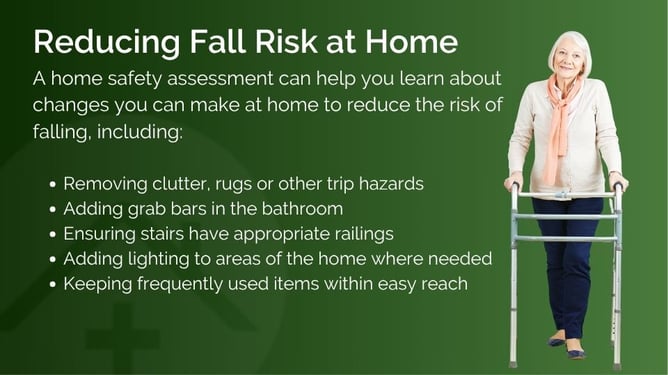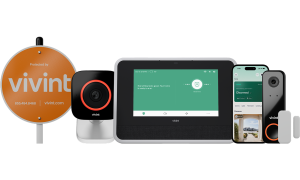Falls are one of the biggest risks for elderly people living at home. If you want to keep your loved ones safe, preventing falls is a must.
Imagine how a simple change in your home could stop a dangerous accident before it happens. You’ll discover easy and effective ways to make your home safer and protect those you care about. Keep reading—because a few small steps today can mean peace of mind tomorrow.
Common Causes Of Falls
Falls are a major risk for elderly people. They can lead to serious injuries and loss of independence. Understanding what causes falls helps in preventing them effectively. Many falls happen due to factors in the home or health issues. Identifying these common causes is the first step to create a safer living space.
Environmental Hazards
Many falls happen because of things around the home. Loose rugs and clutter on the floor cause trips. Poor lighting makes it hard to see obstacles. Uneven floors and slippery surfaces increase fall risks. Stairs without handrails or grab bars are dangerous. Making the environment safe can reduce falls a lot.
Health Conditions
Some health problems make balance and movement hard. Weak muscles and poor vision raise the chance of falling. Conditions like arthritis cause joint pain and stiffness. Problems with the inner ear can affect balance. Dizziness or fainting spells also increase fall risk. Managing these conditions helps lower the chance of falls.
Medication Side Effects
Some medicines cause side effects that increase falls. Drowsiness and dizziness are common problems. Blood pressure medicines can cause lightheadedness. Certain drugs affect coordination or cause confusion. Taking many medicines together raises risks more. Always review medicines with a doctor or pharmacist to stay safe.

Credit: www.liveinhomecare.com
Safe Home Modifications
Creating a safer home environment is crucial for preventing falls among the elderly. Small changes can make a big difference in reducing risks and boosting confidence. Safe home modifications focus on making daily movements easier and more secure, helping your loved ones maintain their independence.
Improving Lighting
Good lighting can dramatically reduce the chance of tripping or missing a step. Consider adding brighter bulbs or installing additional lamps in dim areas like hallways and staircases. Motion-sensor lights are a smart choice, especially for nighttime trips to the bathroom.
Have you noticed how shadows or glare can confuse your vision? Adjusting window coverings to let in natural light during the day can help, too. You might be surprised how a simple change in lighting can improve safety and comfort.
Installing Grab Bars
Grab bars provide essential support in places where balance is most vulnerable, such as bathrooms and stairways. Installing them near toilets, showers, and steps offers a steady handhold that prevents slips.
Make sure to place grab bars at the right height and secure them firmly to the wall. Testing them yourself before relying on them can save a fall later. Have you checked if your grab bars are sturdy enough?
Removing Tripping Hazards
Loose rugs, clutter, and uneven flooring are common causes of falls. Removing or securing these hazards can clear safe paths throughout the home. Opt for non-slip mats and keep walkways free of cords and objects.
Think about the last time you almost tripped—what caused it? Regularly walking through the home and spotting potential hazards from your elder’s perspective can help you catch risks early. Would your loved one feel safer with fewer obstacles in their daily route?
Exercise And Mobility
Exercise and mobility are essential components in preventing falls among the elderly. As you age, maintaining physical activity can significantly reduce the risk of falls by improving balance, strength, and coordination. Engaging in regular exercise not only helps prevent injuries but also enhances your overall quality of life.
Balance And Strength Training
Improving balance and strength is crucial for fall prevention. Simple exercises like standing on one leg or doing heel-to-toe walks can make a big difference. Strength training, using light weights or resistance bands, helps build muscle mass, which is vital for stability. Have you considered joining a community exercise class? It’s a great way to stay motivated and socialize.
Using Mobility Aids
Mobility aids like canes and walkers can offer the support you need to move safely. It’s important to choose the right aid that suits your specific needs. Don’t hesitate to consult with a healthcare professional to ensure you’re using it correctly. Have you ever noticed how a well-fitted cane can boost your confidence in navigating spaces?
Physical Therapy Benefits
Physical therapy can play a pivotal role in enhancing mobility and preventing falls. Therapists design personalized exercise programs that target your specific limitations. They guide you through movements that improve your flexibility and strength. Have you ever thought of physical therapy as a way to regain independence?
By incorporating these strategies into your routine, you can significantly reduce the risk of falls and improve your overall well-being. What steps will you take to enhance your mobility and ensure your safety at home?

Credit: www.facebook.com
Medication Management
Managing medications carefully is key to preventing falls among the elderly. Many medications can cause side effects like dizziness or drowsiness, increasing fall risk. Paying close attention to how medicines are taken and understanding their effects can make a real difference in safety at home.
Reviewing Prescriptions
Keep a detailed list of all medications, including over-the-counter drugs and supplements. Review this list regularly to check for duplicates or conflicting prescriptions. Sometimes, multiple doctors may prescribe similar medications without realizing it, which can cause harmful interactions or side effects.
Ask a pharmacist to explain each medication’s purpose and possible side effects. Knowing why a medicine is taken helps you spot any unusual symptoms early. Have you ever noticed a medication making you or a loved one feel off balance? Sharing this information with your healthcare provider is crucial.
Avoiding Drowsiness
Some medications cause drowsiness or slow reaction times, which can be dangerous around stairs or slippery floors. Pay attention to how a medication affects alertness, especially after starting a new one. If you find it hard to stay awake or focused, discuss alternatives or timing adjustments with a doctor.
Try to schedule medications that cause drowsiness for times when you can rest, like before bedtime. Avoid mixing these with alcohol or other sedatives. Have you noticed that certain pills make you feel sleepy during the day? This could be a red flag to change your medication plan.
Consulting Healthcare Providers
Regular communication with healthcare providers about medications is essential. Bring your full medication list to every appointment and ask questions about any concerns. Doctors and pharmacists can help adjust dosages or suggest safer options tailored to your needs.
Don’t hesitate to speak up if you experience side effects or falls. Your providers rely on your feedback to keep you safe. Have you ever felt hesitant to mention a medication problem? Remember, your safety depends on open and honest conversations.
Emergency Preparedness
Emergency preparedness is a crucial part of fall prevention for the elderly. It ensures quick responses when accidents happen, reducing the severity of injuries. Taking simple steps now can make a big difference in how safely and swiftly help arrives.
Personal Alert Systems
Personal alert systems offer immediate access to help if you fall or feel unwell. These devices often come as wearable pendants or wristbands with easy-to-press buttons.
Some models include fall detection that automatically triggers an alert if a sudden movement or impact is sensed. Imagine being able to call for help even if you can’t reach a phone—this technology can save precious minutes.
Emergency Contact Plans
Having a clear emergency contact plan means you and those around you know exactly who to call. List trusted family members, neighbors, or caregivers and keep the list visible near phones and in wallets.
Share your plan with everyone involved and review it regularly. This avoids confusion during stressful moments and ensures the right people respond quickly.
Regular Check-ins
Scheduling regular check-ins creates a safety net around you. A quick daily call or message from a friend or family member can confirm your well-being and provide peace of mind.
It also creates a routine that makes it easier to spot if something is wrong. Could setting a specific time each day for a check-in be the simple step that protects you?

Credit: www.facebook.com
Lifestyle Adjustments
Lifestyle adjustments play a key role in preventing falls among the elderly. Small changes in daily habits can greatly reduce risks at home. These adjustments promote better balance, strength, and awareness. They also support overall health, making movement safer and easier.
Proper Footwear Choices
Choosing the right shoes improves stability and reduces slipping. Shoes should have flat, non-slip soles. Avoid high heels, slippers, and shoes with smooth bottoms. Good footwear fits well without being too tight or loose. Look for shoes with firm support around the ankles. Replace worn-out shoes promptly to keep grip strong.
Maintaining Vision Health
Clear vision helps detect obstacles and uneven surfaces. Regular eye check-ups ensure proper prescription updates. Good lighting in all rooms reduces shadows and glare. Remove or fix anything that may cause glare or reflection. Use glasses or magnifiers as advised by your eye doctor. Keep pathways free of clutter to aid safe movement.
Balanced Nutrition
Eating well supports muscle strength and bone health. Include foods rich in calcium and vitamin D to keep bones strong. Protein helps maintain muscle mass and repair tissues. Drink enough water to stay hydrated and alert. Avoid excessive caffeine or alcohol as they may cause dizziness. Balanced meals improve energy levels and overall wellbeing.
Frequently Asked Questions
What Are The Top Home Safety Tips For Elderly Fall Prevention?
Keep floors clear of clutter and secure loose rugs. Install grab bars in bathrooms. Ensure good lighting throughout the home. Use non-slip mats in wet areas. Encourage regular exercise to improve balance and strength. Regularly check and maintain assistive devices.
How Can Lighting Improve Fall Prevention For Seniors?
Adequate lighting reduces shadows and highlights hazards. Use nightlights in hallways and bathrooms. Install bright bulbs with warm tones. Motion-sensor lights can alert seniors to obstacles. Proper lighting helps seniors navigate safely, especially at night.
Which Home Modifications Help Prevent Elderly Falls?
Install grab bars near toilets and showers. Use non-slip flooring materials and mats. Add handrails on stairs and ramps. Remove tripping hazards like loose cords. Consider a walk-in bathtub or shower seat for safety.
How Does Exercise Contribute To Fall Prevention In Elderly?
Exercise improves balance, strength, and flexibility. Activities like walking, tai chi, and yoga are beneficial. Regular movement enhances coordination and confidence. Physical fitness reduces the risk of falls and injuries. Encourage consistent, safe exercise routines for seniors.
Conclusion
Keeping elderly loved ones safe at home requires simple, clear steps. Remove tripping hazards like loose rugs and clutter. Use grab bars and good lighting in key areas. Encourage regular exercise to improve balance and strength. Check the home often for new risks or changes.
Small actions can prevent serious falls and injuries. Safety means peace of mind for everyone. A safer home helps elderly people live with confidence and independence. Taking these steps today protects their health tomorrow.








